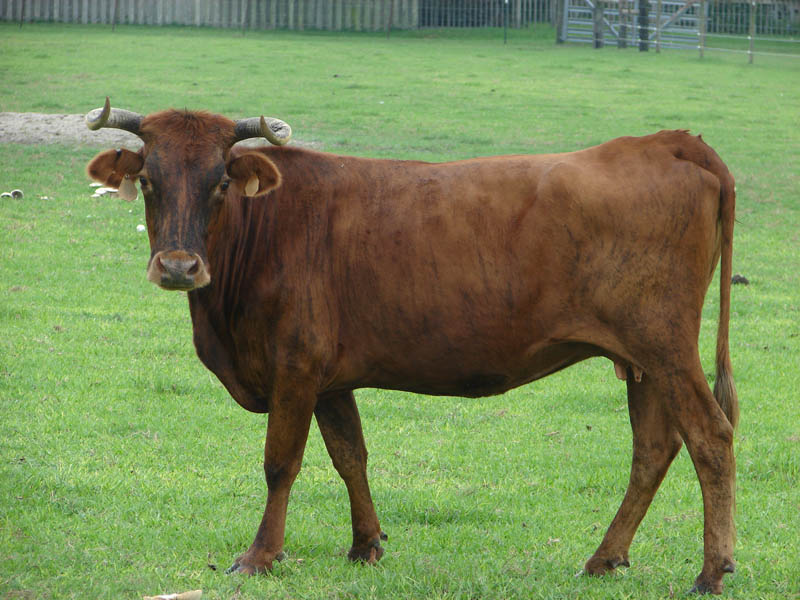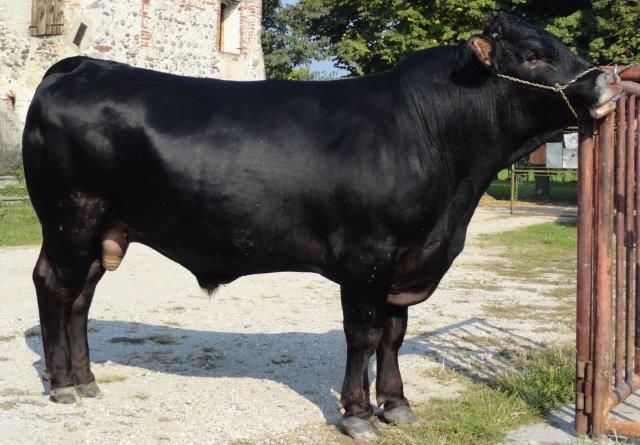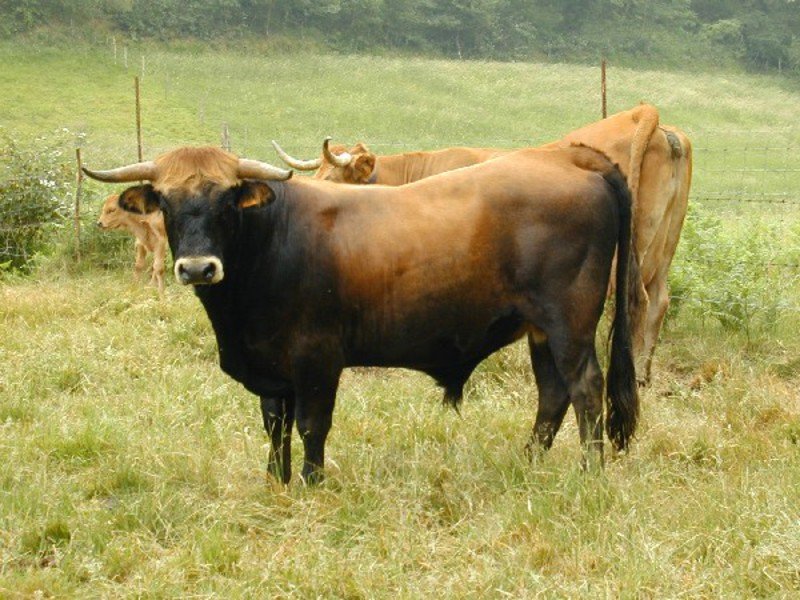Genetic
diversity is an essential trait a population must have for being fit to be
released into the wilderness. A genetically diverse population has a higher
chance for adapting against diseases, predators and other obstacles of living
in the wild and also enables a higher speed of adaption (Fisher’s fundamental
theorem). So it is not only important to breed aurochs-like cattle for
aurochs-like traits and ecological suitability, but also to keep the
population(s) genetically diverse at the same time.
Now that we
have a couple of breeding-back projects and breeds (Taurus cattle and good Heck
cattle, the Tauros Project, the Uruz Project*, the Auerrind Project), how broad
is the genetic basis?
Sayaguesa
is a breed that is used in four of these breeds/projects (Taurus, Tauros,
Auerrind and probably Uruz), and at least three of them got their current
individuals from the same herd in the Netherlands (owned by Peter van
Geneijgen). Taurus and Auerrind both use Chianina, and got their animals from
the same herd of Rainer Titzentaler. So the animals are related to some degree.
Heck cattle originally had a broad genetic basis because the Hecks gathered
breeds from all over Europe in a time when there was less exchange, but went
through several genetic bottlenecks so it is questionable if the breed can
still be considered genetically diverse despite its large phenotypic
variability; especially since one of the best herds that recently had a big
influence on many good Heck herds, the former herd of Walter Frisch, is an
inbreeding line.
* It has been long ago that the True Nature
Foundation gave clear information on this project, and it seems that there has
been one more split, so I have to neglect this project here for now.
Although I
think that genetic diversity can be overrated as well (look at feral cattle
populations that have a long history – many of them have a narrow genetic
basis) as long as the animals are genetically healthy and do not carry too many
deleterious alleles, and the genetic base that we currently have is probably
enough for the sporadic, small-patched possibilities of releasing them into the
wild in modern Europe especially if there will be exchange between the
different populations in the future (which I hope, more on that in an upcoming
post). The easiest way to increase the genetic diversity of the “breeding-back
population” as a whole would be to either cross in breeds currently not used or
create new herds working with new breeds. This would not imply a decrease in
quality since the breeds currently used are not necessarily the best of the
best, but there are many other cattle breeds on this world that are just as
advantageous. The choice of the current breeds probably depended on
availability, coincidence, experience et cetera. With this and the following
post, I want to outline a number of breeds that would be just as good as, in
some cases even better, than the breeds currently used in order to inspire
people working in projects or planning to set up new projects.
But before
that, I want to give an overview over the breeds currently used in
“breeding-back” and in which project (italics):
Chianina – Taurus, Auerrind
Heck cattle
– Taurus, on its own
Highland
cattle – Tauros
Limia – Tauros
Lidia – Taurus (formerly)
Maronesa – Tauros
Pajuna – Tauros
Podolian
cattle (Maremmana, Grey cattle, Boskarin, Podolica…) – Tauros, Taurus, Auerrind
Rhodopian
shorthorn – Tauros
Sayaguesa –
Tauros, Taurus, Auerrind
Watussi – Taurus, Auerrind
Additionally
to that, there are breeds that are not used in the form of pure individuals but
single crossbred animals like Tudanca (Tauros), Holstein (Taurus), Alistana-Sanabresa
(some of the Sayaguesa in Taurus, Tauros and Auerrind).
There are
plenty of alternatives to the current breeds in Europe alone, and with the set
of breeds that I am going to introduce here it would probably be possible to
gain all the desired aurochs-like traits to a more or less satisfying extent.
There are of course many alternatives from other places of the world as well,
but I start with the continent breeding-back is focusing on.
Note that I
completely leave aside unpublished claims on alleged genetic proximity to wild
aurochs here. Furthermore, of course all of these breeds have their con’s as
well, you would have to pick the right breeds to cross them with – so if your
first reaction to my proposal of this and that breed is something like “what,
this breed, look at its tiny horns”, I am of course aware of that and would
therefore propose to use it in a combination with a breed that compensates this
deficiency, and so on.
Alternatives
in Europe (incl. breeds of European descent)
Angeln
The presence
of this breed on my list might surprise, but there are Angeln cattle that exhibit
two precious traits: long snouts, especially in cows, and inwards-curving horns
in an aurochs-like manner. Furthermore, they should be well-suited to Central
and Northern European climate. One would, of course, have to avoid individuals
with huge udders and other derived traits. By the way, Angeln cattle were also among the founding breeds of Heck cattle, which shows in a number of individuals.
Agerolese
Agerolese
is a crossbreed of native Italian cattle with more derived, northern breeds
like Frisian, Jersey and Braunvieh. They are very small (bulls only 130-135cm
at the shoulders) and so are their horns, but their colour is aurochs-like with
some degree of sexual dimorphism and the curvature of the horns often is
acceptable as well.
Alistana-Sanabresa
This breed
is being used indirectly in the form of Sayaguesa individuals slightly influenced
by that breed, but if one needs another breed that is similar in build and horn
shape with slightly larger horns and a lighter colour (in both sexes though),
this breed is an option.
Avilena
This breed
is rather similar to Sayaguesa too and probably closely related. They are
smaller though, and seem a bit more bulky. Many carry the Ed mutation which causes a wholly black colour, but the
wildtype allele E+ is
present as well.
Busha
Just based
on their optics, Busha do not really knock me off the socks. However, they are
probably suited very well to the climate of the Balkans (and other regions of
Europe) and can be a basis for cross herds.
Barrosa
Many
Barrosa are small, bulldog-faced and dachshund-legged, and their horns are not
that thick. But I am sure that in the variability of the breed individuals can
be found that are higher in build with less shortened faces and good, thick
horns. Such individuals would be a good option to crossbreed with f.e.
Sayaguesa and similar breeds. As for its similar sister breed, Cachena, I
consider it a bit too small, stubby and short-faced.
Betizu
Betizu
would be a prime option because of their feral history. Of course they are
small, have dilution factors that modify their coat colour and their horns are
not good either, but that can be compensated by crossbreeding.
Caldela
Another
breed that is rather similar to Sayaguesa in looks, but smaller (140cm for
bulls, ~130cm for cows).
Camargue
Camargue
could be very advantageous because of their high-legged, slender and athletic
build. The horns are rather upright (but they curve inwards) and they do not
have the wildtype colour allele, but I think this breed would be rather
advantageous. They are rather small, but I think their deer-like elegance is
precious. Nowadays, they are often crossed with Lidia, so one would have to pay
attention on not picking too aggressive and massively built individuals.
Chillingham
The
advantage of this breed is that they have been living under rather harsh
conditions for centuries and are resistant to a number of diseases like
foot-and-mouth disease. Their century-long life in a virtually feral state must
have left traces in natural and social instincts and resistance to climate
which would be rather beneficial for a breeding-back population. Apart from
that, they are not closely related to the mostly Southern European breeds
currently used. They have large, sometimes long-snouted heads and single
individuals have a remotely aurochs-like horn curvature. This breed is rare, only
two herds exist, but maybe the cattle warden would be willing to make one young
bull available.
Corriente
Corriente
have a rather aurochs-like, muscular build with a well-pronounced hump. Their
legs are slender, some have long snouts as well. The horn curvature is good to
very good in single individuals. They display a number of colour variants and
an accurate aurochs colour is among them. Corriente would be as beneficial as
Lidia, without being overly aggressive or bulls growing heavily massive at high
age. The biggest disadvantage is a logistical one: it is an American breed and
importing individuals would be very effortful. So maybe they could only be used
via semen. For some videos showing Corriente with a good build and horn shapes,
go here or here.
Eringer
The
disadvantages of this breed are obvious: small, massive, bulldog-faced and
dachshund-legged. However, my proposal of this breed here is based on a
discussion on the Carnivora Forum Aurochs thread, where Eringer was discussed
being used as a “quantity breed” for building up cross herds, in the same way the
Tauros Project is using Highland cattle. As a sole “quantity breed”, Eringer
would probably be more advantageous than Highland cattle. Plenty of them have
the right colour, a muscular body with a hump, and thick horns slightly curving
inwards. They are probably suited to central European climate.
Florida
Cracker
This breed
is small, but advantageous because rather hardy and what is very precious: a
lot of cows have very aurochs-like, strongly inwards-curving horns (there are
no bulls with aurochs-like horns however, but this is a general phenomenon in
domestic cattle). They exist in many colour variants, aurochs-like colour among
them. Like other American breeds, they would have to be either imported or used
via semen.
Maltese
Maltese
cattle would be a rather awesome breed to work with. It is said to be of the
same size as Chianina, but expresses mostly an undiluted wildtype colour, is of
a magnificent build and has rather long snouts. The problem is their very small
population, so their availability would depend on if the owners would be
willing to provide a project with semen of a bull or not.
Modicana
Modicana is
an Italian breed that could be very useful. It has a build that is rather
similar to Pajuna, some individuals are slender and well-shaped and they are
large according to the Domestic Animal Diversity Information System (160cm for
bulls, 145 for cows). The horns are not impressive, but I would suggest using
that breed at any time if they are that large indeed.
Murciana
Body shape
and size of this breed are not sensational, but some cows seemingly have horn
shapes that could be useful for crossbreeding, and they have retained some
degree of colour dimorphism (though, as in most cattle breeds, imperfectly).
Pisano
This
Italian breed is comparable to Agerolese, but not as small (140-155 for bulls).
It is influenced by Chianina and Braunvieh, has an acceptable body shape and
good colour. The horns are tiny.
Rendena
Rendena is another small Italian breed with a good colour and average body, it is probably the most aurochs-like alpine breed.
Serrana-Negra
This breed
is, like Avilena, comparable to Sayaguesa and probably closely related, but
smaller and less long-legged. Good individuals would probably still be a useful
basis for crossbreeding, especially since some cows, just like in Sayaguesa,
have aurochs-like horns.
Terrena
Terrena is
perhaps comparable to Pajuna or Limia, and small and rare. However, their body
shape and colour is fine. The horn curvature mediocre.
Tudanca
Tudanca is
used in the form of some half-Tudanca individuals in the Tauros Project.
However, I suggest also using it on a larger scale. Regarding its size, the
DADIS contradicts itself: it gives a withers height for bulls of 165cm and
160cm for cows and states “small sized with great sexual dimorphism”. Based on
most videos I have seen I dare to doubt that they reach large sizes on average.
Nevertheless, some Tudanca have a rather good body shape (see the videos here
and here), their horns are at the edge of what I would call “large”, skull
shape is ok. They have the same dilution allele as Podolian cattle and
Grauvieh, but dilution alleles can hardly be avoided. Some bulls are wholly
black without a saddle, cows always lightly coloured.
Texas
Longhorn
This breed
is comparably small, but rather hardy. The big advantage however is that it one
of the very few more or less aurochs-like breeds that have really large horns.
The only aurochs-like breed that rivals Texas Longhorn in having decently long
and thick horns are large-horned Heck cattle. They display many colour
variants, including aurochs-coloured individuals. One would have to pick the
right individuals.
Vianesa
Vianesa is
rather similar to Limia, although the bulls tend to be rather lightly-coloured.
Body shape and horns are acceptable. They are not large, comparable to Heck
cattle in size.
Now I
briefly introduced a lot of breeds (I could have introduced even more), many of them are from the Iberian
peninsular and some of them might be closely related to each other and/or some
of the breeds already used. The gain of genetic diversity would be much higher
when including cattle from the group I am introducing in the next post, and
they would also bring some phenotypic advantages.
































._JUAN_MART%C3%8DNEZ%2C_2014._tcm7-313552.jpg)







I was wondering what your opinions on the Texas Longhorn and Watusi crosses being a useable cross are? I see you mentioned the Texas Longhorn and I know that Watusi is already used in other programs. And since these crosses are already readily available in the U.S.A. They might easily be able to cross with your proposed cross off chianina and maronesa and get a nice auroch looking horn.
ReplyDeleteYes, they would also be an option to me as well.
DeleteThere are quite some small breeds...Curraleiro would fit in then, also.
ReplyDeleteYes, as I wrote, I could have included plenty more breeds.
DeleteI'd like to thank you for taking the time to write these articles up. They are always full of great information, and it was nice to learn about a few breeds I hadn't heard of before. Will you be doing another article on breeds from Asia or Africa? This question is unrelated, but I was wondering how mass dnt breeds you think are appropriate to start a back breeding program? I think I read once that uruz thought the Taurus program used too many
ReplyDeleteWhat is a "mass dnt breed"?
DeleteA"mass dnt breed" is a lesson on why you should always preview what you typed before hitting post, especially on a phone. I meant to type: " how many different breeds". For example maybe eight founding breeds then only using the crosses from those eight to continue.
ReplyDeleteI think that there is no rule of thumb for that. It depends on what you want to achieve. Choosing many different breeds creates a broader genetic basis, but also introduces more undesired traits and therefore achieving stability takes longer and vice versa. One would have to pay attention on picking a set of breeds that both shows a minimum of undesired traits but also is not closely related.
DeleteSo does that mean that if using Florida cracker for instance it would be wise to not use one of the more popular Spanish breeds due to a common ancestry? It's very interesting to see all of the breeds that you list that aren't currently used in any program, but if trying to narrow a few different breeds into what would be the founding herds it seems a bit daunting.
DeleteI am confident that all achievable aurochs traits and be achieved with the selection I introduced here (if you are talking about that), one would have to pick the right breeds, but I am going to make a post on that too. And no, I am not saying that any currently used breed should not be used in new projects, but I am saying that for more genetic diversity, there are other but less-considered breeds that might be just as good.
DeleteI can't wait to read your post in picking the right breeds. I was just thinking that maybe the Florida cracker and Spanish breeds may be closely related since that is area in Europe most of their genes came from. Do you think the domestic cattle that were abandoned on the Alaskan islands could one day end up looking like miniature auroch if left alone?
DeleteSome Portuguese Cattle and Horse Breeds:
ReplyDeleteSome Portuguese Cattle Breeds:
http://www.marones.pt/
http://www.amiba.com.pt/
http://www.amiba.pt/
http://www.cachena.pt/
http://www.cachena.es/
https://www.cachena.de/de/index.htm
http://www.bovinoalentejano.pt/
http://www.ancra.pt/
http://www.amiba.com.pt/
http://www.amiba.pt/
http://www.azores.gov.pt/
http://www.cachena.pt/
http://garvonesa.blogspot.com/
http://jarmelista.pt/
http://www.acrm.pt/
http://www.marinhoa.com/
http://www.marones.pt/
http://www.mertolenga.com/
http://www.minhota.com.pt/
http://agrominhota.wix.com/racaminhota
http://www.mirandesa.pt/
http://www.racapreta.com.pt/
http://www.bovinoramogrande.pt/
Some Portuguese Horse Breeds:
http://www.acerg.net/
http://www.acerg.net/index.php?option=com_frontpage&Itemid=1
http://www.cavalo-lusitano.com/
http://www.aicsorraia.com/
http://www.aicsorraia.com/index.html
http://www.aicsorraia.fc.ul.pt/ISAG2000.PDF
http://www.aicsorraia.fc.ul.pt/criadores_portugal_modelo.htm